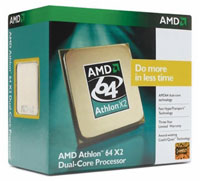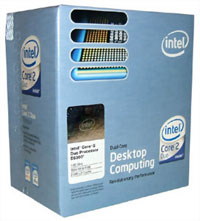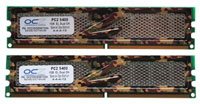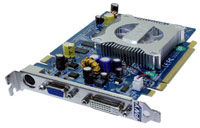Basic Midrange Configurations
We'll start with the Intel and AMD options for what we consider a basic midrange computer. These will offer good performance for a variety of tasks, but they are not tailored towards anything in particular. Before we get into the actual component lists, let's take a moment to clarify a few things. First, a lot of people certainly don't need all of the options we are listing below. Dual core processors are faster for some tasks, but there are still plenty of applications that run perfectly well on older systems, and they certainly don't need the processing power offered by a dual core CPU. Not everyone needs 2GB of memory, a discrete graphics card, a relatively large hard drive, etc. However, we are building what we consider to be a good all-around computer, and individualization can still be beneficial. If you're looking to cut costs a bit further, you can find additional information and advice in our last
Entry Level Buyer's Guide.
A second topic that we need to address is the question of AMD Athlon X2 versus Intel Core 2 Duo processors. If performance is your primary consideration, there are very few areas where Core 2 Duo isn't faster. Once you reach the Core 2 Duo E6600, it becomes faster than just about any official AMD Athlon X2 processor in overall performance, and the only way you will surpass its performance is with overclocking. When you start overclocking both platforms, however, Core 2 Duo is basically out of reach of AMD's current processor line. So Core 2 Duo is the way to go, right?
In actuality, AMD has done what most companies do when their product does not offer best in class performance: they cut prices, sometimes quite drastically. Motherboards for AMD systems also tend to be a bit less expensive than their Intel counterparts. The net result is that while Intel is undoubtedly the faster processor overall, AMD is very competitive - and perhaps even better - when it comes to price/performance. That goes double if you plan on getting a single core processor, as Intel doesn't offer any compelling single core solutions right now. We're sticking with dual core processors for our midrange and higher recommendations, but whichever way you choose to go the bottom line is that you can get a lot of performance without spending a ton of money, so try to spend your money where it will offer the most benefit.
| AMD Mid-Range Base System |
| Hardware |
Component |
Price |
Rebates |
| Processor |
Athlon 64 X2 3800+ AM2 (2x512K 2.0GHz) - Retail |
$133 |
|
| Motherboard |
DFI Infinity NF ULTRAII-M2 |
$95 |
|
| Memory |
OCZ S.O.E 2x1GB DDR2-667 (OCZ2SOE6672GK) |
$221 |
$30 |
| Video Card |
PNY GeForce 7600GS 256MB (VCG7600SXPB) |
$96 |
|
| Hard Drive |
Seagate 320GB SATA 3.0Gbps 7200RPM 16MB (Barracuda 7200.10) |
$90 |
|
| Optical Drive |
LG Black 18X DVD+R (GSAH22N-BK) |
$36 |
|
| Case |
Cooler Master Centurion 534 (RC-534-KKN2-GP) |
$66 |
$10 |
| Power Supply |
FSP Group (Fortron Source) 450W (AX450-PN) |
$62 |
|
| Display |
Acer AL2016W 20" 8ms (1680x1050) |
$233 |
|
| Speakers |
Logitech X-530 5.1 70W Speakers |
$74 |
|
| Keyboard and Mouse |
Microsoft Comfort Curve 2000 B2L-00047 |
$28 |
|
| Operating System |
Windows XP MCE 2005 (with Vista coupon) |
$115 |
|
| Bottom Line |
|
$1249 |
$1209 |
| Intel Mid-Range Base System |
| Hardware |
Component |
Price |
Rebates |
| Processor |
Intel Core 2 Duo E6300 (1.86GHz 2MB Shared) - Retail |
$185 |
|
| Motherboard |
Biostar TForce965PT (P965 775) |
$111 |
|
| Memory |
OCZ S.O.E 2x1GB DDR2-667 (OCZ2SOE6672GK) |
$221 |
$30 |
| Video Card |
PNY GeForce 7600GS 256MB (VCG7600SXPB) |
$96 |
|
| Hard Drive |
Seagate 320GB SATA 3.0Gbps 7200RPM 16MB (Barracuda 7200.10) |
$90 |
|
| Optical Drive |
LG Black 18X DVD+R (GSAH22N-BK) |
$36 |
|
| Case |
Cooler Master Centurion 534 (RC-534-KKN2-GP) |
$66 |
$10 |
| Power Supply |
FSP Group (Fortron Source) 450W (AX450-PN) |
$62 |
|
| Display |
Acer AL2016W 20" 8ms (1680x1050) |
$233 |
|
| Speakers |
Logitech X-530 5.1 70W Speakers |
$74 |
|
| Keyboard and Mouse |
Microsoft Comfort Curve 2000 B2L-00047 |
$28 |
|
| Operating System |
Windows XP MCE 2005 (with Vista coupon) |
$115 |
|
| Bottom Line |
|
$1317 |
$1277 |
 |
 |
For your typical midrange computer, we've gone with a selection of high-quality parts that offer a great price/performance ratio. With either of the above systems, you should easily be able to run all current applications, along with Windows Vista, with one possible exception: games. You can even run all current games, just not at maximum detail settings or high resolutions. The performance edge goes to the Intel E6300 build, but obviously the performance advantage comes with a pricing disadvantage. If you want to spend the same amount of money on both platforms, you could actually put an Athlon X2 4600+ into the AMD system and end up with typically better performance than the E6300. If you don't plan on stressing the CPU a lot, however, even an X2 3800+ on is more than sufficient. If you need more information about the various processors available, you may find it helpful to refer to our
Holiday CPU Guide.
The motherboard selections were chosen with an eye towards stability and cost without sacrificing performance. The AM2 motherboard actually uses the older NVIDIA nForce4 chipset, but we have found the performance and stability offered to be beyond reproach in the DFI motherboard. Likewise, the Biostar TForce 965PT is one of the most compelling P965 solutions currently available, offering good performance, stability, and features. Overclocking is also an option on either of these motherboards, and while they may not be the absolute best overclocking options around, they should be more than sufficient for the majority of users. Strictly in terms of features, the edge belongs to the DFI board, as it includes FireWire support. It is possible to get FireWire for socket 775 but it will usually require spending a bit more money than the Biostar board.
 |
Finding good DDR2 memory without spending a lot of money is still difficult, although prices have dropped quite a bit in the past several months. There are a few DDR2-800 offerings available that only cost a bit more money than DDR2-667, but with 5-5-5 timings instead and once you factor in mail-in rebates we feel that the OCZ S.O.E. (that's "Special Ops Edition" if you were wondering) DDR2-667 is probably the best option right now. It runs at 4-4-4 timings with 1.9V and shouldn't have any problem posting at 1.8V, and with a bit higher voltage you should be able to overclock to at least DDR2-800 (if you want to). We wouldn't go beyond about 2.1V for this memory, as that tends to be the safe limit for anything that doesn't use Micron D memory chips.
 |
The choice of graphics card is one of the more difficult decisions, but what is best is going to vary greatly by individual. The GeForce 7600 GS is a good entry level GPU, providing the features and performance necessary to accomplish most tasks. AMD's Radeon X1650 Pro offers a similar level of performance at a slightly higher price. Either one should work well, but if you need more options for graphics cards, check out our recent
Holiday GPU Guide.
Choosing among the different storage components these days usually ends up coming down to price as the deciding factor, as the performance offered is very close between the various brands. For the hard drives, we also factored in price per GB, and ended up with 320GB models being the best overall choices. Seagate and Western Digital are the least expensive brands and they both offer good performance and features, with Hitachi, Samsung, and Maxtor (who is now owned by Seagate) being the other major brands. The Western Digital 320GB Caviar SE16 and Seagate Barracuda 7200.10 320GB both cost around $90 and it's basically a tossup determining which is better. Both brands trade punches in benchmarks, coming in faster in some tests and slower in others; Seagate seems to do better in multimedia applications while Western Digital does better in multitasking scenarios, but in day-to-day use most people likely wouldn't be able to tell the difference.
















43 Comments
View All Comments
KorruptioN - Friday, January 19, 2007 - link
That 500W unit is built by ATNG, the 600W PSU in the guide comes from Solytech/Deer. Two completely different OEMs. ATNG is still not regarded very highly around the Internets, but they're working on it.As for the number of DOAs being higher (which may indeed be true), what happens when the entire computer is taken out by a faulty PSU that fails catastrophically on it's secondary side? Sure they'll give you a new power supply, but you'll still be out of a functioning computer.
Operandi - Friday, January 19, 2007 - link
Rosewill has many OEMs for it's units.That unit reviewed by Jonny Guru has absolutely no bearing on the unit recomended in the article. One good Rosewill unit doesn't make the rest of them so. The only thing that matters is how the unit is built, not the sticker on the outside.
crydee - Friday, January 19, 2007 - link
I would of recommended the Corsair HX-520 for the mid-range overclocking guide it's cheaper and performs awesome. You guys saw the 620W version take on 2 8800GTXs >_<